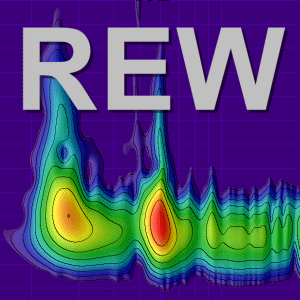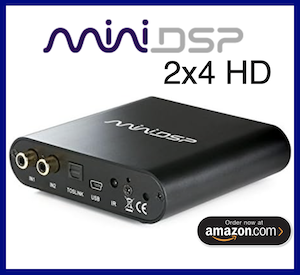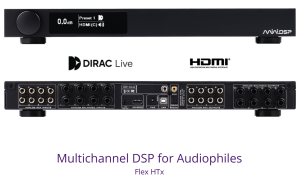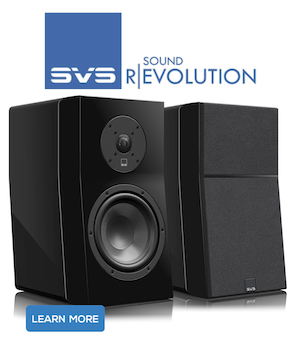I've heard from some folks that running sweeps, like the one in REW, can damage some tweeters - specifically the more fragile metal types like beryllium. Is there any way that the sweep in REW - even at its longest length - could do such a thing?
-
AUDIO VIDEO PROCESSING, SETUP & ENVIRONMENTOfficial REW (Room EQ Wizard) Support Forum Audiolense User Forum Calibration Equipment Auto-EQ Platforms / Immersive Audio Codecs Video Display Technologies / Calibration AV System Setup and Support Listening Room / Home Theater Build Projects Room Acoustics and Treatments AV Showcase Movies / Music / TV / Streaming
-
AUDIO VIDEO DISCUSSION / EQUIPMENTHome Theater / Audio and Video - Misc Topics Essence For Hi Res Audio AV Equipment Advice and Pricing Awesome Deals and Budget AV Equipment AV Receivers / Processors / Amps UHD / Blu-ray / CD Players / Streaming Devices Two Channel Hi-Fi Equipment DIY Audio Projects Computer Systems - HTPC / Gaming HD and UHD Flat Screen Displays Projectors and Projection Screens AV Accessories Buy - Sell - Trade
Navigation
Install the app
How to install the app on iOS
Follow along with the video below to see how to install our site as a web app on your home screen.
Note: This feature may not be available in some browsers.
More options
You are using an out of date browser. It may not display this or other websites correctly.
You should upgrade or use an alternative browser.
You should upgrade or use an alternative browser.
Can sweeps damage tweeters?
- Thread starter tony22
- Start date
John Mulcahy
REW Author
- Joined
- Apr 3, 2017
- Posts
- 9,061
Sure. Tweeters are generally power dissipation limited, if you feed them signals at levels that are too high for too long they will suffer thermal damage. REW's sweeps have a pink spectrum, so the energy falls at 10 dB per decade as frequency increases. The time the sweep spends going from 10 kHz to 20 kHz is the same as the time it spends going from 10 Hz to 20 Hz, so the high frequency part of the sweep is traversed quickly, but if you use high levels and long sweeps you can cause damage. There is no need to use high levels for acoustic measurements.
John Mulcahy
REW Author
- Joined
- Apr 3, 2017
- Posts
- 9,061
What matters is the SPL that is produced and the length of the sweep. You can't tell the SPL from the sweep level setting as it depends on the interface and amplifier gains, the system volume setting and the speaker sensitivity. If you have calibrated the SPL reading or you are using a calibrated USB mic you can use Check levels to see the corresponding SPL, or look at your graphs. 75 dB SPL is sufficient for acoustic measurements and is very unlikely to damage any speaker, even those with limited power handling. The longer the sweep, the more time it spends in the frequency range of the speaker and the more power the tweeter has to dissipate. I have made thousands of measurements with 256k sweeps at around 75 dB SPL and never seen any damage at all to any speaker I have measured.
Yep, I do. And I never go above 75dB SPL. What if I was using the longest sweep length available?If you have calibrated the SPL reading or you are using a calibrated USB mic you can use Check levels to see the corresponding SPL, or look at your graphs. 75 dB SPL is sufficient for acoustic measurements and is very unlikely to damage any speaker, even those with limited power handling.
John Mulcahy
REW Author
- Joined
- Apr 3, 2017
- Posts
- 9,061
A 256k sweep at 48 kHz sample rate lasts about 5.5 seconds. A full range sweep spans about 10 octaves and the tweeter would typically be active during the last 3 octaves, so for a little less than 2 seconds. It would take a very loud signal to overheat a tweeter in less than 2 seconds. A 4M sweep lasts 16 times as long, so the tweeter would be active for about 30 seconds. A loud signal could overheat a tweeter in that time. REW's longer sweeps are provided to facilitate high signal-to-noise ratio measurements of electronic equipment, particularly at very high sample rates. I don't know why anyone would use them for speaker measurements.
Is 4M new? I thought 1M was the longest sample rate; that's what I'd been using.
Here's what's got me scratching my head. After reading about this I decided to see if my tweeters could reproduce out to 20KHz. My speakers are well designed, with a FR spec'd out to -2dB at 20KHz. I set up my UMIK-1 with the capsule inches in front of the tweeter, facing it. I used the RTA tool but wasn't sure if I should run Pink Noise to do this test. Is this a legitimate test? Or, maybe I should ask, how would I do a test like this? The tweeters on both speakers sound fine, with no distortion or obvious problems, but I'd like to figure out how to test them just for my own sanity.
Here's what's got me scratching my head. After reading about this I decided to see if my tweeters could reproduce out to 20KHz. My speakers are well designed, with a FR spec'd out to -2dB at 20KHz. I set up my UMIK-1 with the capsule inches in front of the tweeter, facing it. I used the RTA tool but wasn't sure if I should run Pink Noise to do this test. Is this a legitimate test? Or, maybe I should ask, how would I do a test like this? The tweeters on both speakers sound fine, with no distortion or obvious problems, but I'd like to figure out how to test them just for my own sanity.
John Mulcahy
REW Author
- Joined
- Apr 3, 2017
- Posts
- 9,061
Just use a sweep. The mic should be very close, a fraction of an inch. The sweep level will need to be much lower than for a listening position measurement due to the mic's proximity. Mic calibration may be inaccurate at the highest frequencies.
High Concept
Registered
- Joined
- May 23, 2017
- Posts
- 2
Is there some theory floating around that the measurements must be made at high SPLs? That a sweep at 75 dBA SPL is “better” (more accurate, yields more data, etc.) than one at 70, or even 65? Run six sweeps, 5 dBA apart, 50 to 75 dBA at the mic position, and plot them on the same page. The curves are identical in the frequency axis and proportional in the amplitude axis. This won’t change until the background noise in the room becomes a factor (low S/N ratio). Vis-a-vis tuning or evaluating your room, all the response curves are equally valid.
Assuming a satisfactory S/N ratio, the only need I can see for a particular sweep SPL is to answer the question, “how flat (in dB) is my room?” – which has no answer – to “how flat is my room in the presence of a stimulus at X dBA?” Or, of course, to be consistent over time.
Assuming a satisfactory S/N ratio, the only need I can see for a particular sweep SPL is to answer the question, “how flat (in dB) is my room?” – which has no answer – to “how flat is my room in the presence of a stimulus at X dBA?” Or, of course, to be consistent over time.
High Concept
Registered
- Joined
- May 23, 2017
- Posts
- 2
Actually, my rhetoricalness was aimed at the world in general, not directly at you! But it's an interesting, if subjective, question.I think I understand your rhetoricalness.So maybe the question is - how much over the ambient SPL is enough for the sweep SPL to be effective?
What I do know is that my afternoon is blown. After lunch, I am going to set this up in my recording studio (noise floor: 27 dBA) and repeat this from 80 dbA down to mud. My tweeters are beryllium (Focal Trio6 be) but I have factory spares in a drawer. Ah, the life of a geek!
Steve Johnson
Redwood City, CA
My tweeters are beryllium (Focal Trio6 be) but I have factory spares in a drawer. Ah, the life of a geek!


 Good luck!
Good luck!John Mulcahy
REW Author
- Joined
- Apr 3, 2017
- Posts
- 9,061
Level shouldn't be a concern, you'll be measuring right at the tweeter. Drop the sweep level 20 dB from where you normally set it and see what you get.If I use a calibrated SPL meter and run it right up to the midrange, say, just to get an easier way to read SPLs, what should it measure right up at the speaker to do this?
I set up a short sweep and positioned the capsule of the mic right in front of the tweeter (trickier than I expected!). Both tweets measure out essentially flat to 20KHz. All good. Thanks to all who helped.Level shouldn't be a concern, you'll be measuring right at the tweeter. Drop the sweep level 20 dB from where you normally set it and see what you get.
Popular tags
20th century fox
4k blu-ray
4k uhd
4k ultrahd
action
adventure
animated
animation
bass
blu-ray
calibration
comedy
comics
denon
dirac
dirac live
disney
dolby atmos
drama
fantasy
hdmi 2.1
home theater
horror
kaleidescape
klipsch
lionsgate
marantz
movies
onkyo
paramount
pioneer
rew
romance
sci-fi
scream factory
shout factory
sony
stormaudio
subwoofer
svs
terror
thriller
uhd
ultrahd
ultrahd 4k
universal
value electronics
warner
warner brothers
well go usa














